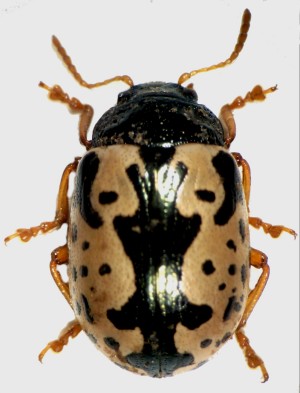Elm Calligrapha
 Scientific Name
Scientific Name
Calligrapha scalaris
Host
Found almost entirely on American elm. A species of dogwood has been found infested on a few occasions.
Symptoms
The adults chew oval or circular holes in the leaves. The larvae devour entire leaves except the veins. Either or both can be heavy enough to defoliate American elms in Oklahoma. Damage seems to be more common in the central half of the-state and less often reported in the far eastern and western counties.
Life Cycle
Adults overwinter in bark crevices, sheltered places around the base of the tree, or in the topsoil. They begin to emerge in late March or early April and lay eggs in April. The larvae feed during late April and May. First generation adults are active from mid-June to late July and give rise to a second generation of larvae. These larvae feed during July and August. Second generation adults are active in September and October and then seek overwintering quarters.
Description
The adult is an elongate-oval, creamy white beetle about 3/8 inch long. The head and thorax are dark, metallic green. Each wingcover bears from 10 to 14 metallic green spots, a dark green, boot-shaped spot at the base, and a dark, metallic green, irregular stripe along the inner edge. Mature larvae are hump-backed and have yellow heads. The body is light yellow or cream with a black line down the middle of the back.
Control
Please contact your local county extension office for current information.

